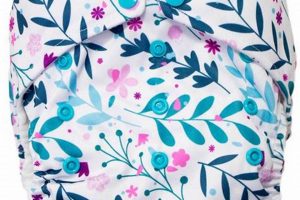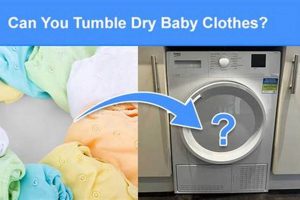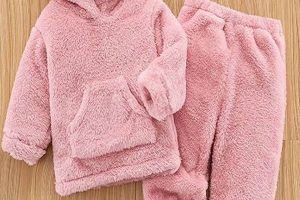Clothing designed for infants and toddlers that offers enhanced accessibility and ease of dressing constitutes a specialized segment within the apparel industry. Garments of this type frequently incorporate features such as wider necklines, adjustable closures, and strategically placed openings to facilitate dressing and undressing, particularly for individuals with limited dexterity or special needs. An example would be a onesie with snaps along the inseam and a fully opening front panel, allowing for changes without fully removing the garment.
The significance of such adaptable apparel lies in its ability to promote independence for caregivers and comfort for the child. It streamlines the dressing process, minimizing discomfort and potential distress, especially crucial for infants who may be sensitive to movement or those with medical conditions. Historically, baby clothing prioritized aesthetics over practicality; however, a growing awareness of diverse needs has spurred innovation and a shift toward functional design principles.
The subsequent sections will delve into specific design elements, material considerations, and emerging trends within this area of children’s wear. Furthermore, the article will examine the impact of accessibility on both consumer behavior and the broader retail landscape. Finally, it will offer insights into the future direction of inclusive garment design for the youngest members of society.
Guidance on Adaptable Infant Apparel
The following recommendations are designed to inform purchasing decisions related to infant clothing that prioritizes ease of use and accessibility.
Tip 1: Prioritize Wide Openings: Seek garments featuring necklines and sleeves designed to accommodate comfortable movement. A wide neckline, for instance, can prevent distress during dressing by minimizing friction against the infant’s head.
Tip 2: Examine Closure Systems: Evaluate the type and placement of closures. Snaps, zippers, or hook-and-loop fasteners should be easily manipulated with one hand and positioned to avoid pressure points on the infant’s body. Look for closures that run the full length of the garment.
Tip 3: Assess Fabric Properties: Choose fabrics that are soft, breathable, and hypoallergenic. Cotton, bamboo, and other natural fibers are generally preferable to synthetic materials due to their reduced potential for skin irritation.
Tip 4: Consider Garment Construction: Inspect seams and labels to ensure they are flat and smooth. Raised seams or scratchy labels can cause discomfort, particularly for infants with sensitive skin. Many manufacturers are adopting tagless designs.
Tip 5: Evaluate Adjustability: Opt for garments that offer adjustable features, such as adjustable waistbands or cuffs. This allows the clothing to accommodate growth and changes in body shape.
Tip 6: Plan for Layering: Select items that can be easily layered to accommodate varying temperature conditions. Bodysuits, for example, can serve as a base layer under other clothing.
Tip 7: Think About Care Instructions: Check the care label to ensure the garment is easy to clean and maintain. Machine-washable and dryer-safe items will save time and effort.
Prioritizing these considerations leads to a selection of infant attire designed for both caregiver convenience and infant comfort, emphasizing practicality in daily routines.
The concluding segment of this article will present a summary of the key findings and project future developments within the industry.
1. Accessibility Features
Accessibility features represent a cornerstone of adaptable infant apparel. The design and incorporation of these features directly impact the ease with which caregivers can dress and undress infants, particularly those with specific needs or sensitivities. The presence of strategically positioned openings, such as envelope necklines or side-snap closures, facilitates smoother transitions, minimizing potential discomfort or distress for the child. As an example, a baby onesie with a full inseam snap closure allows diaper changes without requiring complete removal of the garment, crucial for maintaining a stable temperature and minimizing disturbance during the process.
The inclusion of adaptable closures, like hook-and-loop fasteners or magnetic snaps, further contributes to enhanced accessibility. These alternatives require less dexterity than traditional buttons or zippers, making dressing simpler for caregivers with limited mobility or visual impairments. Moreover, features such as flat seams and tagless designs address sensory sensitivities, reducing the likelihood of skin irritation or discomfort. The deliberate placement of these features demonstrates a commitment to inclusive design, acknowledging the diverse range of needs and capabilities of both infants and their caregivers.
In summary, accessibility features are integral to the functionality and effectiveness of open edit baby clothes. Their implementation directly affects the practical usability of the garment, improving the dressing experience for both infant and caregiver. While challenges remain in achieving universally accessible designs, the continuous innovation and refinement of these features signify progress towards a more inclusive and supportive approach to infant apparel design.
2. Comfort Fabrics
The selection of materials significantly influences the effectiveness of adaptable infant apparel. Comfort fabrics, characterized by their softness, breathability, and hypoallergenic properties, are a critical component in mitigating potential skin irritation and promoting overall infant well-being. The direct correlation lies in the prolonged skin contact inherent in infant clothing; therefore, materials must minimize friction and allow for adequate ventilation. An instance of this is the widespread adoption of organic cotton, cultivated without synthetic pesticides or fertilizers, reducing the risk of exposure to harmful chemicals that could trigger allergic reactions.
The utilization of comfort fabrics extends beyond merely avoiding irritants. Materials like bamboo rayon, known for its inherent moisture-wicking capabilities, play a crucial role in regulating body temperature and preventing the build-up of moisture, a common cause of discomfort and potential skin conditions such as diaper rash. Further practical application involves employing fabrics with a smooth, non-abrasive texture to minimize rubbing against sensitive skin, particularly around seams and closures. Manufacturers often prioritize flatlock seams, a technique that reduces bulk and prevents chafing, enhancing overall comfort and wearability.
In summation, the integration of comfort fabrics is paramount in the design of accessible infant clothing. These materials are not merely cosmetic additions, but rather fundamental elements that contribute to the garment’s functionality and its ability to support infant health and comfort. The ongoing investigation and development of innovative textiles designed to address the unique needs of infants will likely continue to drive advancements in this sector. However, challenges persist in ensuring both affordability and sustainability while maintaining the high standards required for infant apparel.
3. Simplified Closures
Simplified closures form an essential element of accessible infant apparel. They directly contribute to ease of use for caregivers and enhance comfort for infants. The design and implementation of simplified closure mechanisms address a critical need for speed and convenience during dressing and diaper changes. The efficacy of such designs has a direct impact on the stress experienced by both the caregiver and the infant. For instance, magnetic snaps, replacing traditional buttons or zippers, allow for near-instantaneous fastening and unfastening. Side-snap closures on bodysuits provide full frontal access, minimizing the need to manipulate the infant during diaper changes, reducing potential discomfort.
Further analysis reveals the practical advantages of using hook-and-loop fasteners in infant clothing. These closures provide adjustability, accommodating varying infant sizes and allowing for a more customized fit. An example of this is adjustable waistbands on pants, which allow for growth spurts. The impact of simplified closures also extends to inclusivity. Caregivers with limited dexterity or mobility issues find these mechanisms significantly easier to manage compared to traditional closures. Wraparound designs, securing with ties or snaps, are another example that illustrates the importance of simplified closures in accessible infant apparel. These designs reduce the need to pull clothing over the infant’s head, which can be distressing for some infants.
In summary, simplified closures represent a key design consideration for accessible baby clothes. The implementation of user-friendly mechanisms directly enhances the practicality and usability of infant garments. The integration of simplified closures results in more inclusive and comfortable infant apparel. The ongoing challenge lies in developing closure systems that are not only easy to use, but also secure, durable, and safe for infants, especially given the strict regulatory standards governing infant apparel manufacturing.
4. Adaptive design
Adaptive design, in the context of infant apparel, refers to the intentional modification of garment construction to address a spectrum of needs and abilities, rather than adhering to standardized designs. As a core component of accessible infant attire, adaptive design directly affects the ease with which garments can be used. Cause and effect are evident: the cause is a deliberate design choice focusing on adaptability; the effect is a garment better suited for infants with specific needs and caregivers with varying levels of dexterity. For example, a romper designed with a wider neck opening and strategically placed snaps is an adaptive solution to the challenge of dressing an infant with limited head control, or dressing an infant using medical support.
The importance of adaptive design extends beyond mere convenience. It facilitates independence and reduces stress for both the caregiver and the infant. Garments that accommodate medical devices, such as feeding tubes or casts, demonstrate a critical practical application. For instance, a bodysuit with a hidden opening for G-tube access allows for feeding without completely undressing the child, maintaining comfort and hygiene. The design focuses on addressing the daily challenges faced by families managing medical conditions, transforming a basic necessity into a more manageable aspect of care. This understanding of adaptive design is essential for manufacturers, retailers, and caregivers seeking infant apparel that prioritizes functionality and inclusivity.
In conclusion, adaptive design is not merely a feature of accessible infant clothing but a fundamental principle guiding its creation. It represents a shift from standardized designs to solutions tailored to the diverse needs of infants and caregivers. While challenges remain in making these adaptive solutions widely available and affordable, the continued focus on innovative and inclusive designs promises to enhance the lives of infants and families requiring specialized apparel. The future of infant apparel design depends on recognizing adaptive designs as a vital, practical, and necessary element.
5. Easy Care
The concept of “easy care” is intrinsically linked to accessible infant apparel. The practicality of clothing designed for infants is fundamentally determined by the simplicity of its maintenance. Given the frequency of spills, stains, and the general messiness associated with infancy, garments requiring specialized cleaning procedures are inherently impractical and less desirable.
- Machine Washability and Dryability
The ability to launder infant clothing in standard washing machines and tumble dryers is paramount. Garments requiring hand washing or air drying place an undue burden on caregivers. Practical examples include bodysuits, pants, and outerwear explicitly labeled as machine washable and dryer safe, offering convenience and time savings. The implications are reduced time spent on laundry and increased hygiene due to effective stain removal at appropriate temperatures.
- Stain Resistance
Fabrics treated for stain resistance offer a practical advantage in maintaining the appearance and longevity of infant clothing. Garments constructed from materials that repel common stains, such as formula, food, or diaper mishaps, are particularly valued. Stain-resistant finishes prevent stains from setting, facilitating easier cleaning and reducing the need for harsh chemicals. This has a direct impact on the lifespan of the garment and the reduction of potential irritants affecting the infant’s skin.
- Minimal Ironing Requirements
Fabrics that resist wrinkling or require minimal ironing contribute significantly to the “easy care” aspect. Knitted fabrics and those with wrinkle-resistant finishes maintain a presentable appearance without demanding extensive ironing, saving time and effort for caregivers. This feature is particularly beneficial for busy parents or those with limited time for household chores. Garments maintain a neat appearance with minimal upkeep.
- Colorfastness
The property of colorfastness ensures that dyes remain stable during washing, preventing fading or bleeding that can affect the garment’s appearance. Colorfast materials maintain vibrancy after repeated washings, preserving the aesthetic appeal and preventing the transfer of dyes onto other clothing. This characteristic is essential for maintaining the longevity and usability of infant garments, as frequent washing is unavoidable.
These interconnected facets of “easy care” directly enhance the practicality and desirability of accessible infant apparel. By minimizing the time and effort required for maintenance, these features contribute significantly to the overall user experience and improve the feasibility of using specialized clothing designed to address the needs of infants and their caregivers. Continued innovation in fabric technology and garment design should prioritize these “easy care” characteristics to further improve the practicality and appeal of inclusive infant apparel.
6. Durability Needed
The concept of “durability needed” is inextricably linked to accessible infant apparel due to the unique demands placed upon these garments. Infant clothing, by its very nature, is subjected to frequent washing, rigorous activity, and exposure to a wide range of substances. Therefore, the longevity and structural integrity of “open edit baby clothes” are paramount to their practicality and cost-effectiveness. The demand for durability stems directly from the expected frequency of use and the often harsh conditions under which infant garments are utilized. Examples include reinforced seams to withstand repetitive washing, resilient fabrics that resist tearing during active play, and colorfast dyes that endure numerous laundry cycles without fading.
The importance of durability extends beyond mere financial considerations. Safe and reliably functional clothing reduces the risk of garment failure, which can potentially lead to discomfort, irritation, or even injury for the infant. A snap that detaches easily poses a choking hazard, while a seam that unravels can create an uncomfortable or restrictive fit. The selection of high-quality, durable materials and construction techniques directly mitigates these risks, ensuring the safety and well-being of the child. Practical application includes using double-stitched seams in high-stress areas, such as around the crotch and shoulders of bodysuits, and choosing fabrics like interlock knit that resist stretching and distortion.
In summary, “durability needed” is not simply a desirable attribute but an essential requirement for “open edit baby clothes.” The extended lifespan of durable garments minimizes replacement costs and reduces waste, contributing to both economic and environmental sustainability. The selection of appropriate materials and construction methods is crucial for maximizing the garment’s resilience and ensuring its continued functionality and safety throughout its intended lifespan. While challenges remain in balancing durability with affordability and comfort, the emphasis on creating long-lasting, reliable infant apparel remains a priority within the industry.
7. Safety compliance
Safety compliance represents a foundational pillar in the creation and distribution of accessible infant apparel, often referred to as “open edit baby clothes.” The relationship is not merely correlative but causal: adherence to rigorous safety standards directly affects the well-being of infants. The inherent vulnerability of infants necessitates stringent regulatory oversight. Non-compliance can lead to physical harm resulting from hazards such as choking, skin irritation, or exposure to toxic substances. Examples include adherence to CPSIA (Consumer Product Safety Improvement Act) regulations in the United States, which mandates limits on lead content and phthalates, or compliance with EN 71 standards in Europe, addressing flammability and small parts hazards. The practical significance lies in the assurance that garments meet minimum safety thresholds, minimizing risks to the infant.
Further analysis reveals the multi-faceted nature of safety compliance. It encompasses not only material safety but also construction integrity and labeling accuracy. For instance, garment labels must accurately specify fiber content and care instructions, preventing allergic reactions or damage due to improper cleaning. Construction techniques must avoid sharp edges or small, detachable parts that could pose choking hazards. Flame-retardant treatments, if applied, must comply with relevant standards to prevent the release of harmful chemicals. Practical applications include regular testing by independent laboratories to verify compliance with these regulations and thorough documentation of materials and manufacturing processes to ensure traceability and accountability.
In conclusion, “safety compliance” is an indispensable element in the production of “open edit baby clothes.” The commitment to meeting or exceeding regulatory requirements directly translates into safer, more reliable products. While challenges persist in maintaining vigilance across global supply chains and adapting to evolving safety standards, the ultimate goal remains steadfast: to safeguard the health and well-being of infants by ensuring that their clothing poses minimal risk. The continued emphasis on rigorous testing, transparent labeling, and responsible manufacturing practices is paramount to maintaining consumer trust and upholding ethical standards within the infant apparel industry.
Frequently Asked Questions Regarding Adaptable Infant Apparel
The following addresses common inquiries concerning accessibility, safety, and practicality in baby clothing. The information provided aims to clarify key aspects relevant to consumers and caregivers.
Question 1: What constitutes “open edit baby clothes”?
The term refers to infant apparel designed with specific modifications to enhance ease of use and accessibility. These modifications may include wider openings, simplified closures, adaptive designs to accommodate medical devices, and easily manageable care requirements.
Question 2: Why is accessibility important in infant clothing?
Accessibility features improve the ease with which caregivers can dress and undress infants, particularly those with limited mobility or specific medical needs. It reduces stress for both infant and caregiver, promotes independence, and facilitates routine tasks like diaper changes and medical procedures.
Question 3: What safety standards apply to infant clothing?
Infant clothing is subject to stringent safety regulations, including CPSIA in the United States and EN 71 in Europe. These standards address concerns such as lead content, phthalates, flammability, small parts hazards, and chemical safety. Compliance is essential to minimize risks of choking, skin irritation, and exposure to toxic substances.
Question 4: What fabrics are most suitable for infant clothing?
Comfort fabrics that are soft, breathable, and hypoallergenic are recommended. Organic cotton, bamboo rayon, and other natural fibers are often preferred due to their reduced potential for skin irritation. Fabrics should also be easy to care for and durable, withstanding frequent washing without losing their integrity or color.
Question 5: How can caregivers assess the durability of infant clothing?
Durability can be assessed by examining the garment’s construction, material quality, and care instructions. Reinforced seams, resilient fabrics, and colorfast dyes are indicators of a durable garment. Checking for certifications or reviews from other consumers can also provide valuable insights.
Question 6: What are the key considerations when choosing closures for infant clothing?
Closures should be easy to manipulate with one hand, secure, and positioned to avoid pressure points on the infant’s body. Magnetic snaps, hook-and-loop fasteners, and wraparound designs are often preferred for their simplicity and adjustability. It is crucial to ensure that closures are free of small parts that could pose a choking hazard.
These frequently asked questions address fundamental aspects of “open edit baby clothes,” providing essential information for making informed purchasing decisions. Prioritizing accessibility, safety, and practicality ensures the well-being and comfort of infants.
The following section will explore future trends and innovations within the adaptable infant apparel industry, examining potential advancements in materials, designs, and manufacturing processes.
Conclusion
This article has explored the multifaceted considerations surrounding “open edit baby clothes,” emphasizing accessibility features, comfort fabrics, simplified closures, adaptive design, easy care, durability, and safety compliance. These elements are not isolated features but interconnected necessities, contributing to garments that effectively meet the diverse needs of infants and their caregivers. The analysis underscored the importance of selecting apparel that prioritizes both practicality and safety, mitigating potential discomfort and ensuring the well-being of the child.
The future trajectory of infant apparel design will likely be shaped by continued innovation in material science, manufacturing techniques, and a growing awareness of inclusive design principles. Stakeholders, including manufacturers, retailers, and consumers, should advocate for rigorous safety standards and transparent labeling practices. The commitment to creating adaptable, safe, and durable infant clothing serves as a vital investment in the health and comfort of the youngest members of society, promoting a more inclusive and supportive environment for all families. Actionable steps include supporting brands committed to ethical and sustainable practices and advocating for policy changes that prioritize infant safety and well-being within the apparel industry.







